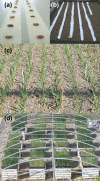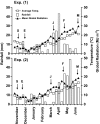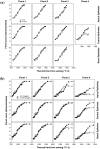Floret development of durum wheat in response to nitrogen availability
- PMID: 20696655
- PMCID: PMC2955747
- DOI: 10.1093/jxb/erq236
Floret development of durum wheat in response to nitrogen availability
Abstract
In Mediterranean durum wheat production, nitrogen (N) fertilization may be important to stabilize and increase yields. Wheat yield responses to N fertilization are usually related to grains per m(2), which in turn is the consequence of processes related to floret development (floret initiation followed by floret death/survival) during stem elongation. The literature is rather scarce in terms of the relevance of floret developmental dynamics, determining the final number of grains in general terms and in particular regarding responsiveness to N. The aim of this study was to determine whether durum wheat responses to N under different water regimes are related to the dynamics of development of floret primordia to produce fertile florets. During the 2006-2007 and 2007-2008 growing seasons, experiments with a factorial combination of two N levels (0 and 100 or 250 kg N ha(-1)) and two levels of water availability (rainfed and irrigated) were carried out (although the water regime was only effective in the second season). The response of yield was largely a consequence of that in grain number per spike. Floret initiation was similar for both N levels in each experiment and water regime, for which the survival of a higher proportion of initiated florets was critical in the response of the crop. The diminished rate of floret abortion during the late part of stem elongation in response to N was associated with a slightly accelerated rate of floret development which allowed a higher proportion of the primordia initiated to reach the stage of fertile floret by flowering.
Figures






References
-
- Abeledo LG, Savin R, Slafer GA. Wheat productivity in the Mediterranean Ebro Valley: analyzing the gap between attainable and potential yield with a simulation model. European Journal of Agronomy. 2008;28:541–550.
-
- Acreche MM, Briceño-Félix G, Martín Sánchez JA, Slafer GA. Physiological bases of genetic gains in Mediterranean bread wheat yield in Spain. European Journal of Agronomy. 2008;28:162–170.
-
- Acreche MM, Slafer GA. Grain weight response to increases in number of grains in wheat in a Mediterranean area. Field Crops Research. 2006;98:52–59.
-
- Austin RB, Cantero-Martínez CJ, Arníe L, Playán E, Cano-Marcellán P. Yield–rainfall relationships in cereal cropping systems in the Ebro river valley of Spain. European Journal of Agronomy. 1998;8:239–248.
-
- Baethgen WE, Christianson B, Lamothe AG. Nitrogen fertilizer effects on growth, grain yield, and yield components of malting barley. Field Crops Research. 1995;43:87–99.
Publication types
MeSH terms
Substances
LinkOut - more resources
Full Text Sources
Research Materials

